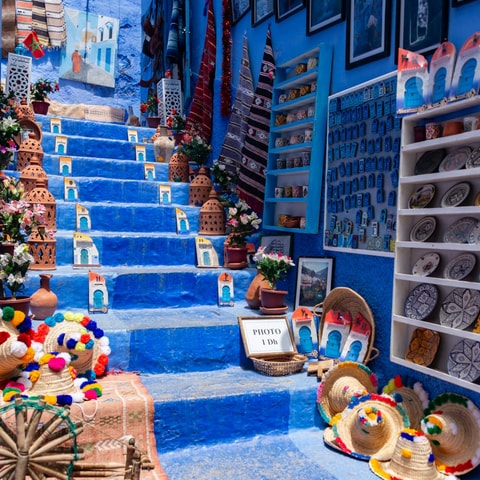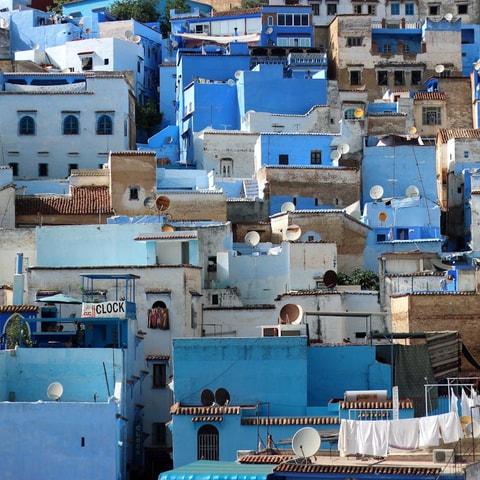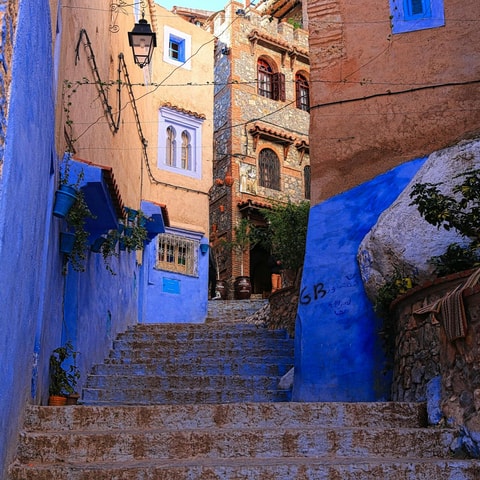Chefchaouen Travel Guide: Morocco’s Blue Pearl in the Rif
Chefchaouen, Morocco travel guide: how to get there, where to stay, what to see. Culture, mint tea, hikes, etiquette—practical tips for the Blue Pearl.
By @charlie_nomade - 02/Oct/2025
Picture: Emma Bosley Ritchie

Chefchaouen, also called Chaouen, Xauen, or “the Blue Pearl”; is a small Rif-mountain city whose identity radiates from its indigo alleys, Andalusian-style homes, and the scent of herbs and spices drifting from the souk. Founded in 1471 as a kasbah outpost amid waves of Andalusi Muslim and Jewish refugees, the town remained closed to non-Muslims for centuries; today its blue palette and slow rhythm make it one of northern Morocco’s most photogenic and welcoming stops.
Currency: Moroccan Dirham (MAD / Dh)
Language: Moroccan Arabic (Darija) and Tamazight; French and Spanish widely understood in tourism.
Climate: Summer 18-30 ºC, Winter 7-17 ºC
Why the Blue Colour in Chefchaouen?
Several histories coexist. A commonly cited origin links the blue to Jewish residents who painted homes in hues recalling the sky and the divine; others point to more recent repainting waves or even mosquito-repellent folklore. Expect a spectrum, from powder blue to deep cobalt-renewed frequently by residents.
How to Get to Chefchaouen

From Tangier (most common): Comfortable intercity buses run daily from Tangier’s CTM/long-distance bus stations to Chefchaouen in roughly 2.5-3 hours, depending on route and stops. Buy tickets at the counter or online; schedules vary by season. There’s no train station in Chefchaouen, so bus or car is the straightforward option.
From Tétouan: Frequent regional buses and shared grand taxis cover the ~1.5–2 hour mountain road.
Chefchaouen’s bus station is below the medina. It’s a pleasant 15-20 minute uphill walk or a short petit-taxi ride to the main gate.
How Long to Stay in Chefchaouen

Many travelers do a long day trip from Tangier, but 1-2 nights let you enjoy blue lanes in quiet morning light, tea at sunset from a rooftop, and nearby hikes (like Akchour waterfalls) without rushing.
Chefchaouen excels in small riads and guesthouses inside the medina or along its edges. Rooftop terraces double as sunrise/sunset lookouts across blue roofs to the surrounding peaks.
What to See & Do in Chefchaouen
1. Uta el-Hammam Square & the Kasbah Museum
Start in the main square beneath the kasbah’s ochre walls. Inside you’ll find gardens, towers with city views, and a compact ethnographic museum about Jbala/Rif culture. Hours and exhibitions change; allow 30–60 minutes.
2. Ras El-Maa Spring
Just beyond the northeastern gate, a cold mountain spring tumbles past old wash stations, great for a cool pause and photos. Continue up from here for the Spanish Mosque trail.
3. Spanish Mosque (Bouzafer) for Sunset
A short, steady path (roughly 1-3 km round-trip, easy/moderate depending on where you start) delivers the classic panoramic of blue lanes ebbing into green mountains-iconic at golden hour. Wear grippy shoes; bring a light layer even in summer.
4. Monday/Thursday Souk (market days)
On market mornings, farmers descend from the Rif with herbs, cheeses, textiles, and produce. It’s outside the medina, lively, photogenic, and very local. (Some sources also note Saturday markets.)
5. Akchour & the “God’s Bridge” day hike
About an hour from Chefchaouen, this gorge rewards with emerald pools and cascades, go with a guide if water levels are high and start early.
Eat & Drink in Chefchouen
Regional specialties to try
- Jben (fresh goat’s cheese): A Rif-mountain staple, mild and creamy, often served at breakfast with olive oil or honey. Look for farm-made versions.
- Kalinti: A warm, chickpea-flour pie sold by the slice street-food comfort.
- Couscous (Fridays), tagines, and mountain herb salads: Many menus lean traditional and hearty.
Tea culture you’ll actually encounter
Mint tea (atay) is the language of hospitality. It’s brewed with green tea and fresh mint, typically sweet, and poured from a height to aerate and raise a little foam—both flavor and flourish. Accept at least the first glass; sip slowly; enjoy the conversation that comes with it.
Culture & Etiquette
 Photography: Ask before photographing people, especially in markets or near homes.
Photography: Ask before photographing people, especially in markets or near homes.- Dress: Chefchaouen is relaxed but conservative; cover shoulders/knees away from tourist strips.
- Haggling: Bargaining is expected in markets-keep it light, friendly, and fair.
- Religious spaces: Many mosques are closed to non-Muslims; admire respectfully from outside unless clearly open.
The Rif mountains around Chefchaouen have centuries of cannabis cultivation history. Since 2021, Morocco regulates cannabis for medical, cosmetic, and industrial purposes only; recreational use remains illegal. You may encounter friendly offers to visit farms or buy hash; politely decline if you’re not interested. If you do engage, understand the legal risks and local sensitivities-public consumption can lead to trouble. The new law created a national regulator (ANRAC) and a licensing framework; it does not legalize recreational use.
Responsible Travel & Respect
Chefchaouen’s calm is part of its magic. Support small, family-run riads and eateries; ask before photos; pack out trash on trails; and keep interactions, whether bargaining or saying “no, thank you”- kind.